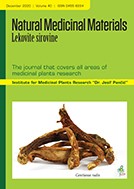Institute for Medicinal Plants Research „Dr. Josif Pančić“ , Belgrade , Serbia
Department of Pharmaceutical Technology and Cosmetology, Faculty of Pharmacy, University of Belgrade , Belgrade , Serbia
Institute for Medicinal Plants Research „Dr. Josif Pančić“ , Belgrade , Serbia
Department of Pharmaceutical Technology and Cosmetology, Faculty of Pharmacy, University of Belgrade , Belgrade , Serbia
The roots of yellow gentian, Gentiana lutea L. (Gentianaceae) are used in traditional medicine for the treatment of gastrointestinal disorders, with the literature data indicate a local gastric effect of gentian root extract (GRE) and support the use of the solid pharmaceutical forms. Gentiopicroside, as a dominant secoiridoid in the GRE, has a short elimination half-life and low bioavailability and, consequently, its bioactivity is limited. The aim of the study was to develop gastroretentive floating delivery system with GRE, and to provide prolonged release of gentiopicroside. Floating granules with dry GRE (DGRE) were prepared by the hot-melt granulation technique, while formulations included effervescent components (citric acid and sodium bicarbonate), hydroxypropyl methylcellulose (HPMC) and meltable binders (Compritol® 888 ATO and Gelucire® 50/13). The flowability of the DGRE and prepared formulations was determined by calculating the Carr index and Hausner ratio. Floating properties and in vitro dissolution rate of gentiopicroside from investigated formulations were examined. Floating granules were characterized with improved flowability (Carr index 14-22 %; Hausner ratio 1.16-1.28) in comparison to the DGRE (Carr index 28.99 %; Hausner ratio of 1.41). Furthermore, the floating granules exhibited immediate and long-lasting buoyancy and prolonged-release of gentiopicroside (over 8 h). Compritol® 888 ATO has provided sustained release of gentiopicroside from floating granules, while HPMC has decreased release rate additionally. On the other hand, Gelucire® 50/13 has increased gentiopicroside release rate. The results have shown that hot-melt granulation technique, as a green granulation method was successfully employed for obtaining gastroretentive floating granules with DGRE.
This is an open access article distributed under the Creative Commons Attribution License which permits unrestricted use, distribution, and reproduction in any medium, provided the original work is properly cited.

The statements, opinions and data contained in the journal are solely those of the individual authors and contributors and not of the publisher and the editor(s). We stay neutral with regard to jurisdictional claims in published maps and institutional affiliations.